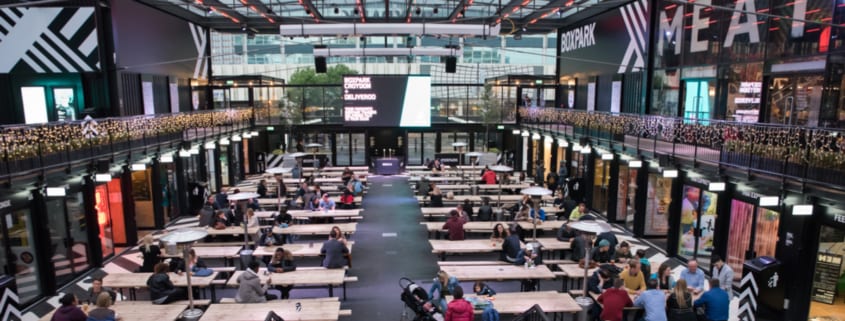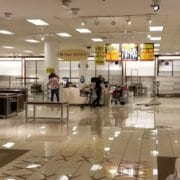The Pop-Up Shop Solution to the Retail Apocalypse
Economic and political upheaval, demographic shifts, and evolving consumer preferences are reshaping the landscape of retail real estate in the United States. These disruptions have resulted in new opportunities for landlords and retailers in the marketplace. Read ahead to learn more about some of the trends occurring today.
The Problem: The Retail Apocalypse
The retail apocalypse is “the closing of a large number of North American brick-and-mortar retail stores, especially those of large chains, starting in 2010 and continuing through 2018”. By the end of the year, almost 4,000 stores will have shuttered – a record-high rate of store shut downs resulting in one of the biggest waves of retail closures in history. Both mall anchors and middle-of-the-mall chains are falling victim, including Toys R Us, Walgreens, Sears, JCPenney, Mattress Firm, Bebe, Gap, Sam’s Club, Gymboree, and Kroger. Some of these stores are leaving the brick-and-mortar business to pursue an online model, while others are just going out of business altogether. And a handful of retailers are aggressively reducing store count to focus on more profitable locations.
To some, the retail apocalypse is not surprising. Some stats show that the US retail landscape is overbuilt by about 20%. The United States has more stores per capita than any other country. America boasts 23.5 square feet of retail space per person, compared to second place Canada with 16.4 square feet and third place Australia with 11.1 square feet. Factoring into this decline are the rise of e-commerce, shifts in how consumers spend their money, and a shrinking middle-class with less discretionary income. Further, retail space is not evenly distributed on a geographic level; supply and demand are asymmetric. Also, we have too much of one retail type (shopping malls) and not enough supply of other types (power centers and grocery-anchored centers).
So, the market must adapt. It’s no secret that about 1 in 4 American malls will close within the next 5 years, particularly with mall traffic having declined over 50% in the past several years. And when a mall loses its anchor stores (typically department stores), it’s nearly impossible for the shopping center to survive, triggering a downward performance spiral that often results in a ghost mall situation. Despite these closures and decreases in traffic, the occupancy rate is still 93%, due to the large amount of total retail square footage in the country.
The Solution: Retail Pop-Up Shops
CBRE defines pop-up shops as “short-term [i.e., temporary] installations either in traditional retail storefronts or non-traditional venues such as shipping containers or kiosks”. According to Reuters, ”The growth of temporary and short-term tenants is partly the result of a power shift to tenant from landlord as retailers consolidate and close stores and fewer look to expand”. The term is most commonly associated with seasonal shops, particularly Halloween stores. Beyond costume shops, other seasonal or short-term pop-ups include toy stores and holidays decorations around Christmas, H&R Blocks leading up to April 15th, and even mobile art exhibits. These tenants are an anomaly in the industry because they can flourish even as regular retail flounders. While mall landlords struggle to find stable tenants, they have plenty of cheap space available and are often willing to offer low, short-term leases. These types of seasonal tenants also draw foot traffic to the mall and provide exposure to other stores.
To be clear though, many of today’s pop-up shops are not your mom-and-pop shops. Short-term tenants are increasingly national, well-known retailers whose brand power can generate significant revenue and traffic for the landlord, including Hermes, Warby Parker, Reebok, Kate Spade, Apple, and Urban Outfitters. Pop-up shops are a popular option for online retailers looking to expand to brick-and-mortar, to introduce an omnichannel strategy, or to tap into the holiday market, including Wayfair, Conde Nast, and Good Housekeeping. This year in particular will be interesting with the closure of Toys R Us stores, as a variety of retailers will fight for their share of the toy market and leverage pop-up shops to capture that toy spend. Other retailers are using pop-up shops to test out new locations, to experiment with different store sizes or formats, or to try out new products before making a heavy investment in new expansion strategies. Pop-ups also enable retailers to collect consumer feedback on these experiments, aiding in longer-term strategic planning. According to CBRE, for many retailers and landlords, even in the case of non-seasonal stores, “the holiday season is the best time of the year to test new concepts, products, and strategies; the sheer volume of traffic and sales that occur over this time period presents high customer exposure and, as a result, a significant sample size from which to capture customer feedback”.
Historically, landlords tried to stay away from pop-up shops and short-term leases, citing concerns over how it looks that they can’t attract long-term tenants and not wanting to risk losing a permanent tenant by signing a temporary one. But now their attitudes have changed somewhat significantly.
Benefits for the Tenant
A short-term lease can help a retailer reduce risk by enabling them to test the success of a new store concept without signing a standard 10-year lease or investing thousands of dollars in interior upgrades and modifications. And as outlined above, they have the opportunity to test new company strategies, products, and markets and garner valuable feedback on the concepts. However, as the economy recovers and vacancy rates drop, pop-ups may face even more competition to secure prime locations.
Benefits for the Landlord
Short-term tenants help landlords generate income from space that is otherwise sitting unused, reducing the number of dark stores, which can affect shopping center traffic. (This is particularly true in the case of pop-ups that can fulfill the role of being a temporary anchor for the mall or shopping center.) These types of temporary tenants can use space as small as 800 square feet and as large as 50,000 square feet; the only requirement is having significant foot or car traffic (i.e., visibility). They typically pay all their rent upfront (often for a period of about two months, though the terms do vary) and agree to leave within days if a long-term tenant is signed. And of course, there is always the chance that the temporary tenant will turn into a long-term lease. Further, many shoppers appreciate the variety offered by pop-up stores, causing some mall landlords to go so far as to designate spaces specifically for rotating pop-ups.
Lastly, a 2016 study from the International Council of Shopping Centers found that real estate owners see higher returns from pop-up shops than from their typical retailers. With pop-up sales outpacing larger tenants, these short-term shops have become a valuable revenue source for shopping malls that strive to provide a unique experience for shoppers. As such, pop-up shops are expected to continue growing in popularity.











